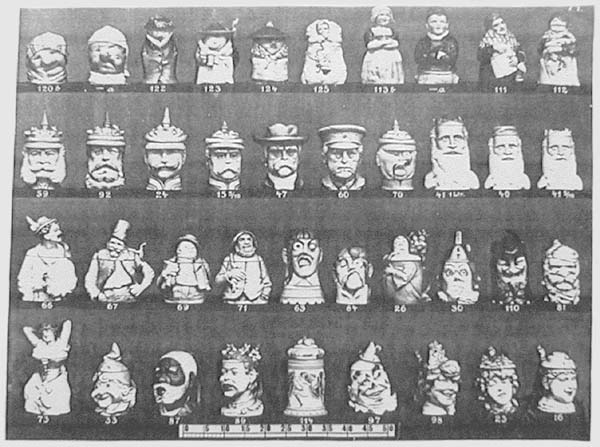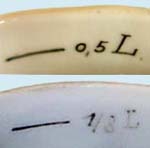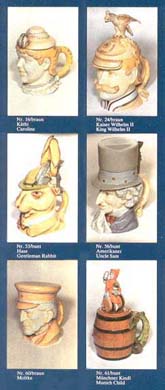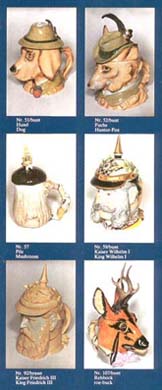
by Frank Loevi
This article is intended as an adjunct to the on-line Schierholz & Sohn Stein Catalog in the Beer Stein Library. Various links provided herein will take the reader directly to examples provided in the catalog. After viewing a catalog example, use the “Back” button on your Internet browser to return to the article.
One of the most respected makers of porcelain character steins during the “golden age” of stein-making, and surely the most prolific, was a company which operated in the small town of Plaue, about 20 miles south of Erfurt in the German State of Thüringen. The name of the company changed several times over the years, but is commonly referred to among collectors as Schierholz & Sohn, it’s name at the end of the 19th century. For purposes of this article, the name “Schierholz” will be used to generically refer to the company, regardless of the name that might have been used during any period being discussed.
At least 115 different character stein designs have been attributed to Schierholz. Moreover, since the company is known to have produced a variety of unmarked special order pieces for various dealers and other organizations, it is quite probable that the actual number of different steins produced at the Plaue factory is much higher. In addition, size variations and significant color variations found on examples from the same basic mold expand substantially the available number of “different” Schierholz steins.
In this article, we’ll briefly explore the stein-making history of the company and then look at some of the unique features of Schierholz character steins that can be used as an aid to identification. Finally, we’ll discuss some excellent late 20th century reproductions with an eye toward distinguishing them from the originals.
Stein-Making History
When Schierholz finally ceased operations as an independent entity 1995, the company had been in business for more than 175 years. That is not to say, however, that it was engaged in the production of character steins during that entire period. In fact, although available documentation is sparse, it would appear to be reasonably certain that character stein production occurred only in short spurts during the life of the organization.
The company that was to eventually bear the Schierholz name was actually founded in 1816 by two merchant brothers from Arnstadt named Heuäcker, one of whom passed away shortly thereafter. In 1817 Christian Schierholz, himself a member of a wealthy Arnstadt merchant family, became a partner in the firm and by later that year he had arranged to buy out the remaining Heuäcker brother. On December 29, 1817, a licence for operating the factory was issued to Schierholz alone.
The company had considerable early success producing porcelain wares used by pharmaceutical and chemical companies and by 1819 had grown to employ to a total of 40 workers. Over time the product line expanded to other items, including a range of hand-painted household wares. In 1849, the company began making lithophanes for the first time, becoming one of the most important lithophane producers in Germany during the second half of the 19th century.
In 1851, Christian Schierholz died and was replaced at the helm by his son Julius, who had been involved with the business for a number of years prior to that time. Following his fathers death, younger son Hugo also joined the company and participated in its management until his own passing just nine years later at only 42 years of age.
In 1877, the company was taken over by Max Schierholz (son of Julius) and Arthur Schierholz (son of Hugo). However, Max Schierholz left the firm some ten years later, so that by 1887 Arthur Schierholz had become sole owner and operator.
It was during this same general timeframe that Edmund Haase was hired as a modeler on April 1, 1886. Although little information is available about Hasse today, he is known to have created designs for the Meissen porcelain manufacturing company that were used to decorate the Bavarian King’s castles at Linderhof, Herrenchiemsee, Berg, and even Neuschwanstein, the “Dream Castle” of King Ludwig II of Bavaria. With those credentials, there can be little doubt that Hasse was one of the top modelers of his day. According to the company, Hasse is responsible for all of the design work for its character steins made during the late 19th century, so it’s reasonable to conclude that the earliest Schierholz character stein production began subsequent to 1886.
During the period between the hiring of Edmund Hasse in 1886 and the death of Arthur Schierholz in 1899, most of the known Schierholz character steins were designed and manufactured. Several catalog pages survive from that time (see, for example, Fig. 1), from which it is possible to compile a fairly complete list of the early Schierholz characters, excluding special order steins which were not part of the Schierholz product line and, hence, not cataloged.
 |
Relying on dates of use for various base marks to establish reference periods (see discussion below), it would appear that character stein production at the Schierholz factory effectively ceased in 1899 and did not begin again until sometime after 1930. When production resumed, surprisingly little use was made of existing molds. Instead, a small series of new molds was created, which included, among others, both the “Skull” and “Skull on Book” steins.
It is interesting to note that the limited resumption of character stein production by Schierholz coincides with the failure of a primary rival, Ernst Bohne Söhne. At the time operations ceased in 1930, ceramic skull-related items made up a significant part of the Bohne catalog, and Schierholz may have seen Bohne’s failure as a potential opportunity. Unfortunately, that proved not to be the case. Based on their rarity today, it would appear that character steins produced by Schierholz in the 1930s, including the skulls, did not attract much consumer attention.
Subsequent to the unsuccessful efforts of the 1930s, there is little evidence to indicate that character steins were manufactured in the Schierholz factory again until 1986, when reproductions of earlier steins began to show up in the marketplace. (These reproductions will be discussed in detail below.) However, following World War II, it would appear that several Schierholz molds may have “escaped” from the factory and found their way into production elsewhere. Modern versions of the “Bismarck” stein, for instance, were distributed by Rastal in the late 1970s, and have also been seen marked “R.P.M.”
In 1995, the company was sold to Seltmann-Weiden Enterprises, which currently owns more than half a dozen German porcelain manufacturers. However, there is no evidence to indicate that character stein production was continued by the new owners of the Schierholz factory.
Schierholz Stein Characteristics
Base Marks — According to literature produced by the Schierholz factory, the base marks depicted below represent all that were used over the entire period that the company was in business. The dates of use beneath the marks were also found in factory literature. It should be noted that the use dates for several of the marks vary considerably from what can currently be found in commonly-used references. This is particularly important for marks A and D which, according to Schierholz, were used from 1860-1899 and 1930-1950, respectively. By way of comparison, the New Dictionary of Marks (Ralph and Terry Kovel, 1986) sets the dates at 1880-1906 and 1907+. These dates are echoed in The Beer Stein Book (Gary Kirsner, 1999). The highly regarded Keramic-Marken Lexicon (Dieter Zühlsdorff, 1994) also sets the dates for mark A at 1880-1906 and, surprisingly, has conflicting information with respect to mark D, with initial usage shown as alternatively as 1907, 1910 and 1924.
Of course, for purposes of dating the steins, usage dates of the various Schierholz marks can be critical and, as may be discerned from the previous section on “Stein-Making History,” the dates claimed by the company have been accepted here as most likely to be accurate. In addition to contrary factory claims, several other factors also call into question the usage dates listed in the various independent reference works, all of which contribute to the conclusion that the Schierholz supplied dates are probably the most reliable. However, those considerations go well beyond the scope and purpose of this discussion and will have to wait for another article.
The remainder of this section, then, will be devoted to a review of the individual marks, with particular emphasis placed on those that are known to have appeared on beer steins.
|
|
Mark A — The Schierholz crosshatch mark and/or the word Musterschutz can be found on most of the company’s early cataloged character steins. Musterschutz appears on 80-90% of the steins, while the crosshatch mark will be seen only about 25-35% of the time. Where the crosshatch appears, it is likely to be seen in conjunction with Musterschutz. The crosshatch mark was hand-applied with blue paint and its appearance varies considerably from example to example. Musterschutz (indicating that the pattern was protected under German law) was stamped with green ink in a seriffed font and was reasonably consistent between examples, so that even where the crosshatch mark does not appear, the green Musterschutz can generally be relied upon as a Schierholz identifier. In some cases, Musterschutz will be found surrounded by quotation marks in the European style (i.e., „Musterschutz“).
Marks B and C — To date, neither of these two marks have been found on beer steins. In fact, they are very rarely seen at all, leading to the probable conclusion that the death of Arthur Schierholz in 1899 was a major setback to the company and that production was severely curtailed from that point until 1930.
Mark D — Other than the crosshatch mark used in the late 19th century, the only other mark found on pre-WWII Schierholz steins is the crown over oakleaf shield. It can be seen as pictured above (stamped in black ink), and also with the addition of text below the shield reading “v. Schierholz” or “von Schierholz.” While this mark is fairly common on Schierholz porcelain appearing in the secondary marketplace, the number of known character steins bearing the mark is quite small.
Mark E — The addition of “Gegr. 1917” (established 1917) to the crown and shield created a minor variation with dates of use that appear to have overlapped those of mark D. That being the case, it is reasonable to conclude that this mark may have been used on character steins. However, if its appearance on Schierholz wares on the secondary marketplace can be considered a valid indicator, the mark was used very infrequently and, to date, is not known to have been seen on a stein.
Mark F — This mark was created specifically to celebrate the company’s 150th anniversary in 1967. It was used only during that year and there is no known use of the mark on character steins.
Mark G — The town of Plaue, home to Schierholz, is in the former East Germany, and in 1972 the company was nationalized by the DDR, at which point its name was changed to VEB Porcellan Manufactur Plaue and the new mark was adopted. The mark continued to be used following the fall of the DDR, and was in use when the reprivatized Schierholz Porcellan Manufactur Plaue finally ceased operations in 1996. It can be found on 1990s reproductions of early Schierholz character steins. Today, PMP continues to exist as an operating division of Seltmann Weiden, a Bavarian conglamorate, but sadly, stein production at the factory has all but ceased.
Mark H — This final mark was created to honor the company’s 175th anniversary in 1992 and was used only during that year. It can also be found on character stein reproductions. However, since the year “1992” is clearly visible in the mark, any confusion between the old and the new is easily eliminated.
 |
Thumblifts — Schierholz character steins can be found with a variety of thumblifts, but plain, flat thumblifts were the norm. In some cases, thumblifts were matched to the theme of the stein. For instance, steins featuring the Munich Child are typically seen with thumblifts depicting the twin towers of Munich’s Frauenkirche (see, for example, the “Munich Child in Barrel” stein). Similarly, the stein depicting Bavarian King “Ludwig II” is generally found with a Munich Child thumblift. On a few occasions, Schierholz used porcelain figurines for thumblifts. By far the best example can be found on the “Nuremberg Judge” stein, where a ceramic jester thumblift is actually integrated into the figural judge’s head lid inlay by way of a connecting “Nuremberg funnel.”
Handles — Perhaps more than those of any other manufacturer, Schierholz character steins tend to have handles that are integrally related to the overall design. Steins depicting animals, for instance, almost always use the animal’s tail to create a handle. One of the most interesting examples of this practice may be found on the “Elephant” stein where, in what appears to be an attempt to add stability, the elephant’s tail rests on an overturned miniature “Sad Radish” stein. Other noteworthy handles can be found on the “Nuremberg Funnel,” the “Heidelberg Student” and the “Mushroom and Gnomes” steins, to mention just a few.
Pedestal Bases — Pedestal bases may be found on a wide range of Schierholz character steins. These additions to the “standard” steins were originally intended to hold music boxes. However, music box steins never achieved widespread popularity and, consequently, are rare today, particularly with a working music box. The pedestals themselves are, for the most part, of standard design and look very much like overturned wash tubs (see, for instance, the “Singing Pig” on a pedestal). The one known exception to this rule is the “Elf Head,” where a pedestal was created specifically to match the stein body. A pedestal alone, without a music box, generally adds little or nothing to the value of the stein. In fact, some collectors find them to be less desirable than Schierholz steins without pedestals, in spite of the fact that they are more rare. On the other hand, a Schierholz stein with a working music box is likely to command a premium of 20-30%.
Lithophanes — About 15% of Schierholz character steins were manufactured with lithophanes; pictures created by varying the depth of the porcelain in the bottom of the stein and viewed by looking through the stein when the bottom is held up to a light source. Lithophanes are rarely seen in porcelain character steins, and most of the known examples were produced in the Schierholz factory. As might be expected, the themes of the lithophanes are tied closely to the subject-matter of the steins, so it comes as no surprise that the lithophane in the “Bicycle” stein depicts a man falling off a high-wheel bicycle, or that the lithophane in the “Target Barrel” stein features a woodland hunting scene. A rare color lithophane depicting a pinboy can be viewed through the bottom of certain “Bowling Pin” and “Bowling Ball” steins.
Schierholz Factory Reproductions: 1986-1995
 |
 |
The first examples of these steins began to show up in the marketplace in about 1986 and were met by loud cries of protest from the collector community due to the strong similarities between the reproductions and the originals. In some cases, the old and the new were so much alike that it was nearly impossible to distinguish the two except by the color of the pewter, which had been artificially “aged” on the reproductions and had a slightly bluish cast not found on the originals. Over time, of course, the pewter on the reproductions will age naturally and begin to look more and more like the originals, ultimately becoming indistinguishable.
On the full-color reproductions there are typically some color variations from the originals, but color variations can also be found between different examples of the same originals (see, for instance, the “Gentleman Rabbit” stein), making clear determinations difficult based on coloration alone.
Perhaps the collector’s best bet when attempting to distinguish an original Schierholz character stein from a 1980s reproduction is to rely on the fact that the bottom markings on the reproductions are far more uniform than on the originals. On reproductions marked as originals, the following factors are consistent:
• Reproductions are always marked with a blue crosshatch;
• Reproduction markings always include a green “Musterschutz”; and
• Bottom glaze always covers the entire bottom surface, as opposed to just the marks.
While all three of these variables can also occur on an original, that will happen only infrequently, at which point other factors must be considered. However, since the absence of any one of the variables eliminates the possibility of a reproduction, which will be true in the vast majority of cases, more sophisticated examination will most often not be required.
By 1990, Schierholz had apparently gotten the message that collectors were resisting reproductions with bogus 19th century markings and began marking the steins with the current company logo (mark G), often in conjunction with a hand-painted year of production. Unfortunately, this effort to please consumers would not appear to have significantly impacted slow sales, and the company was forced to sell out in 1995, only a few years following its return to private ownership.
More to Learn
There is some sparse evidence to indicate that Schierholz may have been involved in steinmaking shortly after the end of World War II and again in the early 1970s, prior to nationalization, but this cannot currently be confirmed. Evidence is also fairly thin regarding what was happening with the company between 1899 and 1930, when production appears to have dropped off dramatically. These are just two of a number of areas where information is sorely lacking about Schierholz and the people that made it work. Moreover, there are still significant questions about the character steins that came out of the Schierholz factory. It is almost certain, for instance, that Schierholz produced many currently unidentified steins under contract to decorator/dealers such as Martin Pauson and Joseph Mayer. As yet, however, no records have surfaced that would help in the identification process.
This article and the on-line Schierholz & Sohn Stein Catalog represent an ongoing attempt to provide a focal point for gathering information about Schierholz and the beer steins produced in the Plaue factory. To the extent that end-users can add to that effort with new discoveries, your contributions are strongly encouraged and will be much appreciated.
__________
© 2001-2026 Beer Stein Library — All rights reserved.